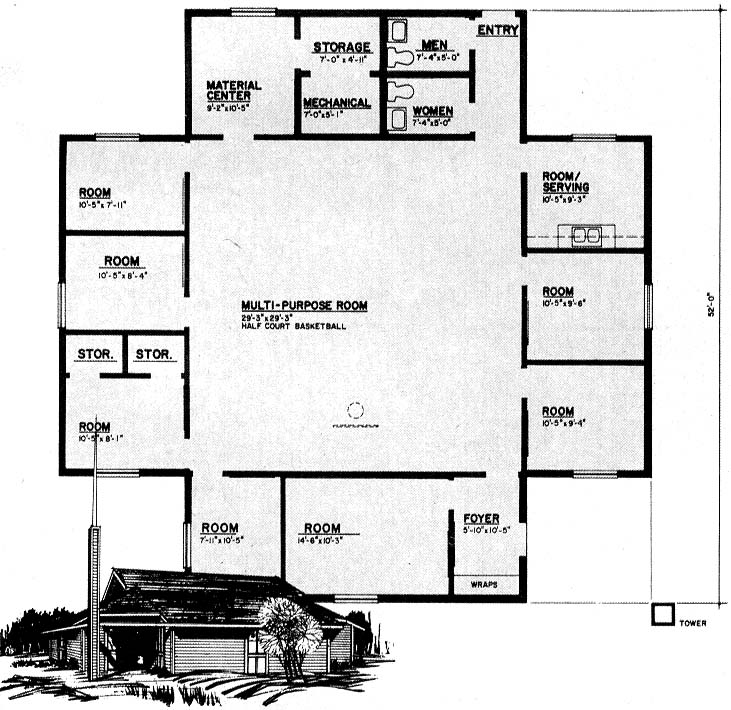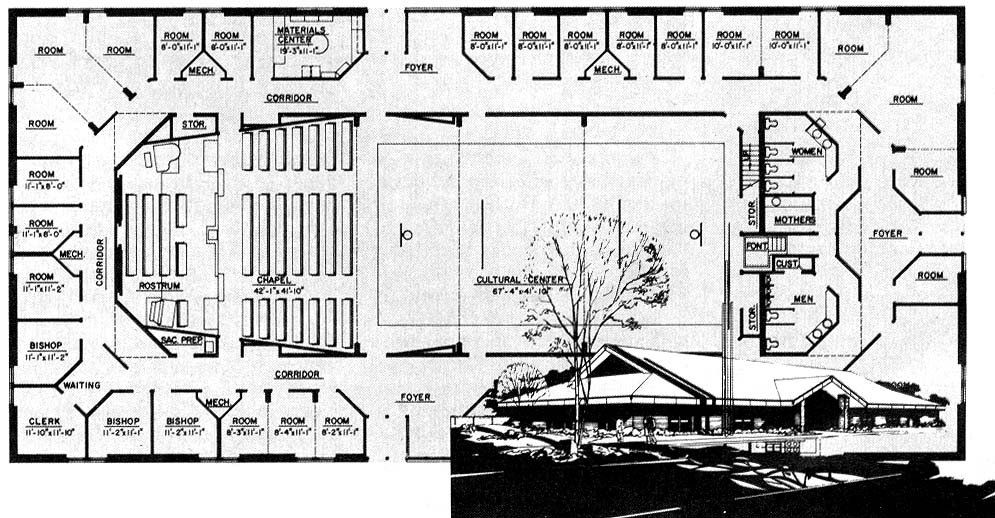“A New Generation of Meetinghouses,” Ensign, Nov. 1981, 108–10
A New Generation of Meetinghouses
Economy and flexibility are important concepts today, and Church members will see that the new meetinghouses are more economical to build, more energy efficient, and generally smaller than most buildings now being used for Sunday worship services and other Church activities.
Depending upon Church population in a given area, a meetinghouse will be constructed according to either the “Aspen” plan or the “Sage” plan. The Aspen, designed to be used by small branches, is a “starter” building which can be constructed in three phases, allowing for expansion as the branch grows. A multipurpose room is used for both chapel and cultural center in the Phase I design. Phase II adds a separate chapel; Phase III enlarges the building with additional classrooms and a separate cultural center.

The “Aspen” is a “starter” meetinghouse which can be expanded as a small branch grows.
Most familiar to wards in the United States and Canada will be the “Sage” plan with some 14,000 square feet, about 5,000 square feet fewer than previous ward meetinghouses. The new building is designed with construction and energy costs in mind; it is estimated that 20 to 30 percent of the initial building expenses will be saved with the construction of each new meetinghouse, and the building will be fifteen to twenty percent more energy efficient than past designs.

The “Sage” will be a smaller, more efficient ward meetinghouse. None have yet been built, but it will become the standard meetinghouse design.
Statistically, most wards have fewer than 200 in attendance each Sunday; hence, the Sage was designed to seat 200 persons in the main chapel, with expanded seating capacity of an additional 550 when folding doors leading to the cultural center are opened.
Visitors to the Sage cultural center (previously the church “cultural hall”) will notice the absence of a fixed stage. Rather, a portable stage is provided, offering significant advantages for theater-in-the-round productions, concerts, and lectures. And when the stage is removed, more room is available for athletics and other activities.
The Sage has been designed with thirty-one teaching stations, some divided by folding doors, to accommodate classes from 14 in number to over 75. As needed, the cultural center can also be divided into classrooms seating more than 150.
The kitchen/serving area features two special pieces of equipment—a movable serving table and a portable dry-hot table. These make serving possible anywhere within the building (except the chapel).
Harold J. Powell of the Church’s Building Division stressed the importance of flexibility within various geographical areas. “Local architects,” he said, “can certainly do some modifications to fit their own local conditions. A typical Wasatch-front building, for example, would simply not be appropriate in Florida.”
The new stake center design, termed the “Cody” plan, is larger than but similar to the ward meetinghouse design. Its 25,000 square feet are arranged in a cost-efficient rectangular shape, complete with extra insulation in the ceiling-to-roof area. The Cody stake center, which replaces all other stake meetinghouse designs, is already in use in a number of U.S. locations.

“Cody” stake centers are already in use across the United States. It’s larger than the ward meetinghouse, similar in design.
According to Robert J. Little, manager of architectural services for the Building Division, the new generation of Church buildings “are designed to make form follow function.” With the consolidated meeting schedule, LDS meetinghouses will become generally smaller and more functional, thus more economical and flexible.
While the new designs will create a distinctive appearance, a sense of the traditional LDS building will be maintained by a tower built in front of the new meetinghouse. Little indicated that the new pole towers will be much less expensive than the block towers so typical of LDS meetinghouses.
Designers Lee Gray and Bruce Edwards said, “New chapel interiors will be attractive with more soft materials and less masonry, with eight-foot-high walls and wooden roof superstructure. All rooms in the buildings will be more flexible and oriented toward multipurpose use.”